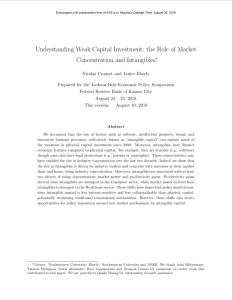Join getAbstract to access the summary!

Join getAbstract to access the summary!
Nicolas Crouzet and Janice Eberly
Understanding Weak Capital Investment
The Role of Market Concentration and Intangibles
Fed Kansas City, 2018
What's inside?
Economists examine the dynamics of corporate capital investment as it relates to economic health.
Recommendation
Economists and business analysts have noted a downward trend in the size, scale and scope of companies’ investments in property, plant and equipment since 2000. Professors Nicolas Crouzet and Janice Eberly examine this anemic capital deployment in the context of higher spending on “intangible capital.” They find that this fundamental shift in many industries confers market advantages that physical capital cannot replicate. getAbstract recommends this insightful report to executives and analysts for its sharp dissection of trends in corporate investment.
Summary
About the Authors
Nicolas Crouzet is an associate professor of finance and Janice Eberly is a professor of finance at the Kellogg School of Management at Northwestern University.


















Comment on this summary